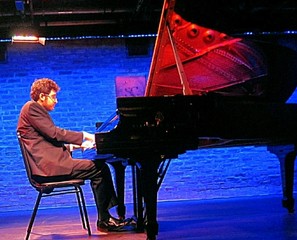|
Back
The Painter As Pianist New York
SubCulture/92nd Street Y
03/02/2015 -
Sir András Schiff Selects: Young Pianists:
Johann Sebastian Bach: English Suite No. 4 in F Major, BWV 809
Johannes Brahms: Variations and Fugue on a Theme by Handel, Opus 24
Béla Bartók: Three Burlesques, Opus 8
Bedrich Smetana: Four Czech Dances
Roman Rabinovich (Pianist)

R. Rabinovich at SubCulture (© Sam von Doggenstein)
When the great Hungarian/British pianist Sir András Schiff selected Roman Rabinovich as a participant in his Young Pianists Series, he hadn’t reckoning on getting two artists for the choice of one. The formidable Israeli is not only an original performer on the Steinway: he is both a palette- and a piano-painter.
Drawings of his four composers of the evening appeared in the SubCulture program and at first glance, they were literal, hardly original. literal. At second glance, they were delightfully quirky.

Rabinovitch sketches (© Sam von Doggenstein)
And while I would love to see a whole exhibition of such a multi-talented person, we had far more important matters to pursue. To be exact, this most formidable one-hour recital.
Yes it did have pictures, though these came not from the eye but from the hands. Mr. Rabinovich painted four piano-pictures that had vibrancy, realism, and a painter’s eye for making them dramatically mobile. They included one bear, one hen, one swordsman, one village of folk-dancers, an apparent man and his wife quarreling, and my favorite, a drunkard trying helplessly to navigate walking.
We come to those later. For initially, it must be stated that Mr. Rabinovich has an uncharacteristic innate feeling for the 18th Century. One doesn’t immediately associate that with young pianists who have such a dynamic technique. But in three works (including an elegant Couperin encore), Mr. Rabinovich showed that the Baroque has its own charms, not to be snared with 21st Century techniques.
The beginning was Bach’s lovely Fourth English Suite. While Bach can be “piano-ed” at times, this work was composed to be plucked, harpsichord style, and Mr. Rabinovich didn’t destroy that expectation. His feet never touched the pedals, his attacks and releases seemed to pluck the notes from the Steinway. Nor did he take any excessive coloration with his notes. This was not tone-painting, it was a sculpture of lines.
That counterpoint showed well in the saraband. But so twinned were his two hands in the courante, so coupled were his lines, the image of Shakespeare’s “two households both alike in dignity” came to the fore.
As for the gigue, Mr. Rabinovich took it at top speed, the two lines following each other, interrupting each other, coupling, jolting apart and coming together at the ending. A fitting end to a work which Bach himself treasured greatly.
Mr. Rabinovich showed equal appreciation for Handel, in the opening of the Brahms Variations. This week Brahms appeared in two carnations: symphonic grandeur and symphonic solemnity, both by the Vienna Philharmonic Orchestra. The Variations showed Bach in a variety of moods, and the trick was linking them together.
Except that one doesn’t need to link these variations. Mr. Rabinovich knew that each was different, and he played them each expressively. It’s useless to take them separately. The audience at SubCulture went from the lilting to the stolid, the highly virtuosic to the light and detached. The main point was that Mr. Rabinovich somehow, innately forced the arch which led to the final fugue, which I consider an apex of Brahms’ piano music.
The fingering was not always right, a few errors were made, but this was a live–a very live–performance, and Mr. Rabinovich is a very human performer.
Finally we come to the pictures. The first three were by Béla Bartók, and these Burlesques are so difficult in score and performance, that most musicians take them at face value, getting them off the ground into the concert hall. Painter Rabinovich didn’t see them that way. He played the two-lined Quarrel the way he played the Bach, except where Bach had a “discussion”, Bartók conceived a vicious argument (supposedly with the composer’s first wife!), and the pianist contrasted, antagonized and ended with a series of lumps, shouts and (probably) a door being slammed shut.
Bartók, the most saintly-looking composer, was not averse to many a jest, and Slightly Tipsy did the impossible. Within very difficult moderate tempo, the piano depicted the victim trying to put one foot in front of another, believing that he was on balance, failing miserably...
The artist was not afraid last night to make this come true. And so picturesque was the feeling that I would love to hear the Uzbek-born Mr. Rabinovich play Mussorgsky’s Pictures one day.
Finally, the great surprise. Not Smetana of the farces or symphonic poems, but Smetana who was known above all as a pianist and piano composer. Perhaps Europe felt they had room for only one Central European virtuoso (Liszt, of course), but Smetana apparently was just as good. And his music, Lisztian in scope, Chopinesque in beauty, and Dvorakian in Czech nationalistic songs, has been sadly underrated.
Not here. These four dances, part of Smetana’s Ten Czech Dances, one better than the other, was played with spark and love. The opening Bear was heavy, the Little Hen a bit twee, a little coy (and why didn’t he offer Coupin’s Hen as an encore?), but the two dances at the end were electrifying.
Sir András, alas, was not present at the recital, perhaps preparing for his two recitals next week. Nor would he have opted for such an eclectic selection. Mr. Rabinovich, though, didn’t need an accolade from that master. He did well on his own, with brilliance, respect and a humor as quirky as his drawings.
Harry Rolnick
|